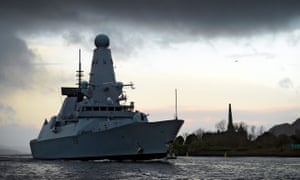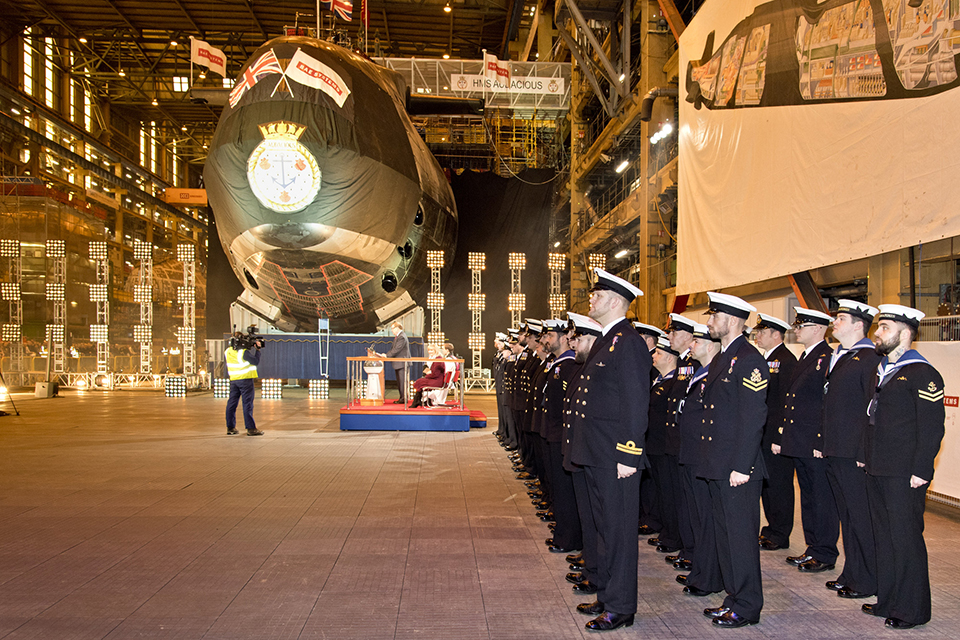Y me parece que ahí no están contados los de la RFAA y tienen unos cuantos por ahí
Si, estan contados hasta los dragaminas, lo cual no deja de ser una cifra impresionante
Y me parece que ahí no están contados los de la RFAA y tienen unos cuantos por ahí

The Guardian
Reino Unido tiene un numero de navios " pateticamente bajo "
Comenzo el " lobby " de la RN en el Parlamento.
Royal Navy
Royal Navy risks having 'pathetically low total' of ships, warn MPs
MoD urged to speed up modernisation of fleet and accused of ‘extraordinary mistakes’ in design of existing ships

Type 45 destroyer. The MoD was strongly criticised by the defence select committee over its engine problems. Photograph: CPOA(Phot) Thomas McDonald/MoD/crown copyright
Kevin Rawlinson
Monday 21 November 2016 00.25 GMTLast modified on Monday 21 November 2016
The Royal Navy will struggle to deal with the threats facing Britain unless the government steps up plans to modernise the country’s fleet, MPs have warned.
According to the defence select committee, the UK already has a “woefully low” number of vessels available and uncertainty remains over plans to replace ageing frigates that are due to be decommissioned by 2035.
The parliamentary committee’s chair, Julian Lewis, said the Ministry of Defencerisked leaving the country with fewer than 19 frigates and destroyers, which he said “was already a pathetically low total”. The MPs said that dropping below that number even for a short time would be “completely unacceptable” and leave the UK vulnerable to threats from sources, including Russia and the Middle East, as well as unprepared to deal with conflicts in the South and East China Seas and to meet its Nato obligations.
“The United Kingdom will then lack the maritime strength to deal with the threats we face right now, let alone in the future. We are putting the MoD on notice that it must not let this happen,” said Lewis, announcing the release of the committee’s report on Monday.
In all, 13 frigates are due to leave the service at a rate of one a year between 2023 and 2035. And the MPs said they had “serious concerns” about the funding and timetable of the fleet that will replace them.
They also attacked the MoD for the “extraordinary mistakes” in the design of Type 45 destroyers after it emerged they had faulty engines. The MPs accused the ministry and contractors of a “serious failing” for under-testing the system, which is unable to operate continuously in warm waters, and warned the problems had “potentially dangerous” consequences.
“It is astonishing that the specification for the Type 45 did not include the requirement for the ships to operate at full capacity – and for sustained periods – in hot regions such as the Gulf,” the committee said.
“The UK’s enduring presence in the Gulf should have made it a key requirement for the engines. The fact that it was not was an inexcusable failing and one which must not be repeated,” it added. “Failure to guarantee this would put the personnel and ships of the Royal Navy in danger.”
Two new classes of frigate, the Type 26 global combat ship and the Type 31 general purpose frigate, are planned to modernise the fleet.
“As an island nation, the importance of the Royal Navy to UK defence must not be underestimated,” the committee said. “Our starting point in this report is our conviction that the current number of frigates, destroyers and personnel inadequately reflects the potential threats and vulnerabilities facing the UK and its interests overseas.”
Lewis added that the numbers of Royal Navy escort vessels have been “severely in decline” in recent decades. “The fleet is now way below the critical mass required for the many tasks which could confront it, if the international scene continues to deteriorate. What remains of our surface fleet now faces a prolonged period of uncertainty, as the frigate class is replaced in its entirety and all our destroyers undergo urgent, major remedial work on their unreliable engines.”
An MoD spokesman said: “We are investing in a growing Royal Navy by building two aircraft carriers, the new Type 26 global combat ship, Dreadnought and Astute class submarines, and offshore patrols vessels.
“We are also developing new class of lighter general purpose frigate so that by the 2030s we can grow the size of the fleet. This major programme of investment will ensure that the Royal Navy remains one of the world’s most modern and powerful navies, with a genuine global reach.
“Type 45 Destroyers are hugely capable ships and have been deployed successfully on a range of operations worldwide. They continue to make an enormous contribution to the defence of the UK and our international partners.
“We’re committed to improving the Type 45’s power and propulsion system through a series of machinery upgrades during planned maintenance, and this work is progressing well.”
Los recortes en todos los sectores, mas alla de las capacidades de cada sistema, son evidentes.
Saludos
Incluso con los recortes siguen estando en otra liga, a la que ni vislumbramos acercarnos...
Ni seria racional acercarnos
Competir HOY con una economia cuatro veces mayor seria algo insensato
Lo llamativo es ver que de ser la primerisima economia del planeta en 1900 y ostentar la Armada que, comparada, con todo el resto en aquella epoca, podia mantener a raya a todos los contendientes, hoy esta en el sexto o septimo puesto .... y en franco descenso.
Hoy sin el apoyo de Otan los rusos les harian pelo y barba.
Cuestiones economicas. El Imperio Britanico es un recuerdo cada vez mas lejano.
Saludos
La Royal Navy era grande, el problema por aquellos años era que el Imperio Británico era inmenso, por lo que la flota estaba muy dispersara al rededor del Mundo.
PerdónLa " Home Fleet " podia mantener a raya a la " Kriegsmarine " y a la " Regia Marina " ella sola.
Y le sobraba para desplegar en Oriente y el Atlantico Sur
Saludos

Perdón
La Home Fleet (Scapa Flow) era la que podía mantener a raya a la Kriesgsmarine, siempre manteniendo por lo menos 2 acorazados modernos.
Para la Regia, tenían la Fuerza H en Gibraltar y la Mediterranean Fleet en Alejandría.
En el 40, desplegaron una fuerza de cruceros desde Malta, pero sino me falla la memoria era un desprendimiento de la Mediterranean, que una vez que intervinieron los alemanes en el Mediterráneo, con los bombardeos fue retirada.
Esto más o menos en los años 1940/41.
Cuando, surgió la amenaza del Japón, se formó en Singapur la Fuerza Z (Prince of wales y Repulse). Ya conocemos el destino de ambos buques.

Y antes que esa, tenemos la Eastern Fleet en Ceylan. Que se retiro en hacia los puerto de Africa Oriental con la incursion de Nagumo en el IndicoNo te olvides que posteriormente se desplegó la Task Force 57 en el teatro de operaciones del Pacífico.
The fleet included 6 fleet carriers, 4 light carriers, 9 escort carriers and 2 aircraft maintenance carriers, with a total of more than 750 aircraft, 4 battleships, 11 cruisers, 35 destroyers, 14 Frigates, 44 smaller warships, 31 submarines, and 54 large vessels in the fleet train.


